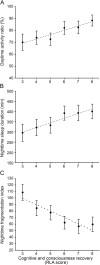Parallel recovery of consciousness and sleep in acute traumatic brain injury
- PMID: 28003503
- PMCID: PMC5272791
- DOI: 10.1212/WNL.0000000000003508
Parallel recovery of consciousness and sleep in acute traumatic brain injury
Abstract
Objective: To investigate whether the progressive recuperation of consciousness was associated with the reconsolidation of sleep and wake states in hospitalized patients with acute traumatic brain injury (TBI).
Methods: This study comprised 30 hospitalized patients (age 29.1 ± 13.5 years) in the acute phase of moderate or severe TBI. Testing started 21.0 ± 13.7 days postinjury. Consciousness level and cognitive functioning were assessed daily with the Rancho Los Amigos scale of cognitive functioning (RLA). Sleep and wake cycle characteristics were estimated with continuous wrist actigraphy. Mixed model analyses were performed on 233 days with the RLA (fixed effect) and sleep-wake variables (random effects). Linear contrast analyses were performed in order to verify if consolidation of the sleep and wake states improved linearly with increasing RLA score.
Results: Associations were found between scores on the consciousness/cognitive functioning scale and measures of sleep-wake cycle consolidation (p < 0.001), nighttime sleep duration (p = 0.018), and nighttime fragmentation index (p < 0.001). These associations showed strong linear relationships (p < 0.01 for all), revealing that consciousness and cognition improved in parallel with sleep-wake quality. Consolidated 24-hour sleep-wake cycle occurred when patients were able to give context-appropriate, goal-directed responses.
Conclusions: Our results showed that when the brain has not sufficiently recovered a certain level of consciousness, it is also unable to generate a 24-hour sleep-wake cycle and consolidated nighttime sleep. This study contributes to elucidating the pathophysiology of severe sleep-wake cycle alterations in the acute phase of moderate to severe TBI.
© 2016 American Academy of Neurology.
Figures


Comment in
-
A good sleep for a fresh mind in patients with acute traumatic brain injury.Neurology. 2017 Jan 17;88(3):226-227. doi: 10.1212/WNL.0000000000003529. Epub 2016 Dec 21. Neurology. 2017. PMID: 28003498 No abstract available.
Similar articles
-
Rest-Activity Cycle Disturbances in the Acute Phase of Moderate to Severe Traumatic Brain Injury.Neurorehabil Neural Repair. 2014 Jun;28(5):472-82. doi: 10.1177/1545968313517756. Epub 2013 Dec 30. Neurorehabil Neural Repair. 2014. PMID: 24379082
-
Sleep-wake disturbances in hospitalized patients with traumatic brain injury: association with brain trauma but not with an abnormal melatonin circadian rhythm.Sleep. 2020 Jan 13;43(1):zsz191. doi: 10.1093/sleep/zsz191. Sleep. 2020. PMID: 31562742 Free PMC article.
-
Sleep in the Acute Phase of Severe Traumatic Brain Injury: A Snapshot of Polysomnography.Neurorehabil Neural Repair. 2016 Sep;30(8):713-21. doi: 10.1177/1545968315619697. Epub 2015 Dec 23. Neurorehabil Neural Repair. 2016. PMID: 26704256
-
Sleep Disruptions in Hospitalized Adults Sustaining a Traumatic Brain Injury: A Scoping Review.J Head Trauma Rehabil. 2024 Jul-Aug 01;39(4):E201-E215. doi: 10.1097/HTR.0000000000000899. Epub 2023 Sep 28. J Head Trauma Rehabil. 2024. PMID: 37767918
-
Sleep disturbance and cognition in people with TBI.NeuroRehabilitation. 2018;43(3):297-306. doi: 10.3233/NRE-182534. NeuroRehabilitation. 2018. PMID: 30347628 Review.
Cited by
-
Pain Perception in Disorder of Consciousness: A Scoping Review on Current Knowledge, Clinical Applications, and Future Perspective.Brain Sci. 2021 May 20;11(5):665. doi: 10.3390/brainsci11050665. Brain Sci. 2021. PMID: 34065349 Free PMC article.
-
Hierarchical clustering of prolonged post-concussive symptoms after 12 months: symptom-centric analysis and association with functional impairments.Brain Inj. 2023 Mar 21;37(4):317-328. doi: 10.1080/02699052.2022.2158229. Epub 2022 Dec 18. Brain Inj. 2023. PMID: 36529935 Free PMC article.
-
Injury, Sleep, and Functional Outcome in Hospital Patients With Traumatic Brain Injury.J Neurosci Nurs. 2019 Jun;51(3):134-141. doi: 10.1097/JNN.0000000000000441. J Neurosci Nurs. 2019. PMID: 30964844 Free PMC article.
-
Twenty-four-hour rhythmicities in disorders of consciousness are associated with a favourable outcome.Commun Biol. 2023 Nov 29;6(1):1213. doi: 10.1038/s42003-023-05588-2. Commun Biol. 2023. PMID: 38030756 Free PMC article.
-
Central autonomic network and early prognosis in patients with disorders of consciousness.Sci Rep. 2024 Jan 18;14(1):1610. doi: 10.1038/s41598-024-51457-1. Sci Rep. 2024. PMID: 38238457 Free PMC article.
References
-
- Duclos C, Dumont M, Blais H, et al. . Rest-activity cycle disturbances in the acute phase of moderate to severe traumatic brain injury. Neurorehabil Neural Repair 2013;28:472–482. - PubMed
-
- Chiu HY, Chen PY, Chen NH, Chuang LP, Tsai PS. Trajectories of sleep changes during the acute phase of traumatic brain injury: a 7-day actigraphy study. J Formos Med Assoc 2013;112:545–553. - PubMed
-
- Gabor JY, Cooper AB, Crombach SA, et al. . Contribution of the intensive care unit environment to sleep disruption in mechanically ventilated patients and healthy subjects. Am J Respir Crit Care Med 2003;167:708–715. - PubMed
-
- Sabir M, Gaudreault PO, Freyburger M, et al. . Impact of traumatic brain injury on sleep structure, electrocorticographic activity and transcriptome in mice. Brain Behav Immun 2015;47:118–130. - PubMed
MeSH terms
LinkOut - more resources
Full Text Sources
Other Literature Sources
Medical
